UMass Extension's Landscape Message is an educational newsletter intended to inform and guide Massachusetts land care professionals in the management of our collective landscape. Detailed reports from scouts and Extension specialists on growing conditions, pest activity, and cultural practices for the management of woody ornamentals, trees, and turf are regular features. The following issue has been updated to provide timely management information and the latest regional news and environmental data.
Welcome to Landscape Message #4 for the 2024 growing season. The next message will be published in one week, on May 10. To receive immediate notification when the next Landscape Message update is posted, be sure to join our e-mail list
Click on the headings below to jump to that section of the message.
In This Issue
Scouting Information by Region
Woody Ornamentals
Scouting Information by Region
Environmental Data
The following data was collected on or about May 1, 2024. Total accumulated growing degree days (GDD) represent the heating units above a 50ºF baseline temperature collected via regional NEWA stations (http://newa.cornell.edu) for the 2024 calendar year. This information is intended for use as a guide for monitoring the developmental stages of pests in your location and planning management strategies accordingly.
|
MA Region/Location |
2024 Growing Degree Days |
Soil Temp |
Precipitation |
Time/Date of Readings |
||
| Gain since last report |
2024 total |
Sun |
Shade |
|||
|
CAPE |
8 |
27 |
51 |
50 |
0.44 |
12:00 PM 5/1/2024 |
|
SOUTHEAST |
30 |
65 |
61 |
53 |
0.50 |
3:00 PM 5/1/2024 |
|
NORTH SHORE |
13 |
24 |
52 |
46 |
0.65 |
9:30 AM 5/1/2024 |
|
EAST |
28 |
54 |
54 |
50 |
0.81 |
4:00 PM 5/1/2024 |
|
METRO |
27 |
49 |
51 |
48 |
0.64 |
6:00 AM 5/1/2024 |
|
CENTRAL |
25 |
51 |
52 |
50 |
1.09 |
12:00 PM 5/1/2024 |
|
PIONEER VALLEY |
40 |
66 |
58 |
52 |
1.10 |
10:00 AM 5/1/2024 |
|
BERKSHIRES |
43 |
56 |
58 |
54 |
1.06 |
5:30 AM 5/1/2024 |
|
AVERAGE |
27 |
49 |
55 |
50 |
0.79 |
- |
|
n/a = information not available |
||||||
US Drought Monitor: At this time, no area of Massachusetts is under official drought status. State map as of Thursday 5/1: https://droughtmonitor.unl.edu/CurrentMap/StateDroughtMonitor.aspx?MA
Phenology
| Indicator Plants - Stages of Flowering (BEGIN, BEGIN/FULL, FULL, FULL/END, END) | ||||||||
|---|---|---|---|---|---|---|---|---|
| PLANT NAME (Botanic / Common) | CAPE | S.E. | N.S. | EAST | METRO W. | CENT. | P.V. | BERK. |
|
Spiraea x vanhouttei (Vanhoutte spirea) |
* |
* |
* |
Begin |
Begin |
* |
Begin/Full |
* |
|
Syringa vulgaris (common lilac) |
* |
* |
* |
Begin |
* |
* |
Begin |
* |
|
Cornus florida (flowering dogwood) |
Begin |
Begin |
Begin |
Begin |
Begin |
Begin |
Begin/Full |
* |
|
Rhododendron spp.(early azaleas) |
* |
* |
Full |
Full |
Full |
Begin/Full |
Full |
Begin |
|
Malus spp. (crabapple) |
* |
Begin |
* |
Begin |
Begin |
Begin |
Full |
Begin |
|
Cercis canadensis (redbud) |
* |
* |
Begin |
Begin |
Full |
Begin |
Full |
Begin |
|
Amelanchier spp. (shadbush, serviceberry) |
Full |
End |
Full |
Full |
Full |
Full |
Full |
Begin/Full |
|
Pyrus calleryana (Callery pear) |
Full |
Full |
Full |
Full |
Full |
Full |
Full |
Full |
|
Magnolia soulangeana (saucer magnolia) |
Full/End |
End |
Full/End |
Full/End |
Full/End |
Full/End |
Full/End |
Full |
|
Prunus serrulata (Japanese flowering cherry) |
Begin |
Full |
Full |
Full/End |
Full/End |
Full/End |
Full |
Full |
|
Rhododendron 'P. J. M.' |
Full/End |
End |
Full |
Full |
Full |
Full |
Full/End |
Full |
|
Rhododendron mucronulatum (Korean rhododendron) |
Full |
* |
Full |
Full/End |
Full |
Full |
Full |
Full |
|
Magnolia stellata (star magnolia) |
End |
End |
Full/End |
End |
End |
Full/End |
Full/End |
Full/End |
|
Forsythia x intermedia (border forsythia) |
Full/End |
End |
Full/End |
Full/End |
Full/End |
Full/End |
Full/End |
Full/End |
| * = no activity to report/information not available | ||||||||
Regional Notes
Cape Cod Region (Barnstable)
General Conditions:
The average temperature for the period from April 17 thru May 1 was 47ºF with a high of 63ºF on April 24 and a low of 28ºF on April 26. Freezes occurred in parts of the upper Cape on April 23, 24, 26, & 27. The period had more sunny days than cloudy. The only significant precipitation occurred on April 20 with approximately a third of an inch.
Herbaceous plants seen in bloom include daffodils (Narcissus spp.), tulips (Tulipa spp.), barrenwort (Epimedium spp.), and lungwort (Pulmonaria officinalis). Woody plants seen in bloom include flowering quince (Chaenomeles speciosa), Japanese kerria (Kerria japonica), and Japanese skimmia (Skimmia japonica).
Pest/ Problems:
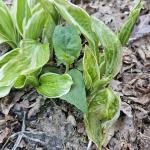


 The freeze of April 26 did cause some damage to herbaceous and woody plants. Damage has been observed on hosta, hydrangea, katsura and magnolia. On hydrangea the damage looks minimal with primarily leaf damage.
The freeze of April 26 did cause some damage to herbaceous and woody plants. Damage has been observed on hosta, hydrangea, katsura and magnolia. On hydrangea the damage looks minimal with primarily leaf damage.
Box tree moth was discovered in several towns of the upper Cape last season. This insect is capable of defoliating boxwood if left unmanaged. Box tree moth is active and should be scouted for; https://ag.umass.edu/landscape/fact-sheets/box-tree-moth
A few tiny winter moth caterpillars were observed while scouting buds of maple. Winter injury and boxwood leafminer have been observed on boxwood. Other insects or insect damage observed during the period include cryptomeria scale on fir, pine bark adelgid on white pine, and black turpentine beetle damage to pitch pine.
Disease symptoms or signs observed include fungal leaf spot on mountain laurel, black knot and black cherry, and white pine needle decline on white pine.
Invasive fig buttercup (Ficaria verna) and invasive garlic mustard (Alliaria petiolata) are in bloom. Other weeds seen in bloom include dandelions (Taraxacum officinale), yellow rocket (Barbarea vulgaris), hairy bittercress (Cardamine hirsuta), chickweed (Stellaria media), mouse-ear cress (Arabidopsis thaliana), henbit (Lamium spp.), and speedwell (Veronica spp.)
Southeast Region (Dighton)
General Conditions:
The weather has been relatively warm and dry. Soils in exposed locations are markedly drier and the surface water in vernal pools has largely subsided. The high temperature over the past two weeks was 75°F on Monday, April 29th. The low temperature was just above freezing at 33° F on the morning of Friday, April 26th. The average temperature since last report was 50°F while the average humidity was 67%. The highest winds where from the South at 17 mph on Tuesday, April 23rd. There were rain showers on Thursday April 18th, Saturday April 20th, and Sunday April 28th for a meager total of 0.50 inches.
Plants in flower include: shadblow (Amelanchier canadesis), redbud (Cercis canadesis), flowering dogwood (Cornus florida), common flowering quince (Cheanomeles speciosa), border forsythia (Forsythia x intermedia), Japanese andromeda (Pieris japonica), Japanese flowering cherry (Prunus serrulata), pear (Pyrus calleryana), crabapple (Malus spp.), Rhododendron 'P. J. M.', and Korean spice viburnum (Viburnum carlesii).
Pests/Problems:
The lack of substantial precipitation recently has dried out top soils while shallow rooted plants are emerging and attempting to expand buds.
The recent discovery of Powassan virus in Massachusetts, a deadly disease vectored to humans by black legged ticks, has given us all yet another reason to be concerned about tick bites.
North Shore (Beverly)
General Conditions:
The average daily temperature was 47˚F, with a minimum temperature of 28˚F recorded on April 26 and a high of 67˚F on April 29. Light rainfall was recorded for a few days during this two-week period. Approximately 0.65 inches of rain were recorded at Long Hill. Soils are moist and suitable for planting; lawns are green, and turf is thriving. Landscapers and homeowners continue to do spring cleaning. Woody plants in bloom include mountain pieris (Pieris floribunda), royal azalea (Rhododendron schlippenbachii), Kwanzan cherry (Prunus serrulata), Korean rhododendron (Rhododendron mucronulatum), large fothergilla (Fothergilla major), and serviceberry (Amelanchier canadensis). Non-woody plants seen in bloom include hellebores (Helleborus orientalis), daffodil (Narcissus spp.), forget-me-not (Myosotis sylvatica), tulips (Tulipa spp.), bleeding heart (Lamprocapnos spectabilis), vinca vine (Vinca minor), and money plant (Lunaria annua).
Pest/ Problems: Invasive garlic mustard (Alliaria petiolata) is thriving and starting to bloom. Other weeds in bloom include common blue violet (Viola papilionacea), dandelion (Taraxacum officinale), and lesser celandine (Ranunculus ficaria). No insect pest activity was observed. However, remember that ticks are very active. Protect yourself with repellent when working outdoors.
East (Boston)
General Conditions:
The past two weeks have been sunny and warm. Daytime temperatures averaged 60ºF, with consecutive high temperatures of 69ºF and 70ºF on April 28th and 29th. Overnight lows averaged 41ºF, although we had light frosts on the 25th and 26th with temperatures dipping to 33ºF and 32ºF, respectively. We received 0.81 inches of precipitation over this period, with 0.37 inches falling April 18th through the 20th. Turfgrass is greening up and plants are leafing out. Some plants in bloom include; Cornus florida f. rubra (pink flowering dogwood), Dirca palustris (leatherwood), Fritillaria persica (Persian lily), Iberis sempervirens (candytuft), Jeffersonia diphylla (twinleaf), and Mertensia virginica (Virginia bluebells).
Pest/Problems:
We received 3.58 inches of precipitation in April; soils remain adequately moist. We did just experience a warm dry spell, only accumulating 0.81" of precipitation over the past two weeks. Container plantings and recent transplants may require supplemental irrigation. Small winter moth caterpillars (Operophtera brumata) have been observed feeding on the emerging foliage of Malus spp. (apple). Alliaria petiolata (garlic mustard) is flowering.
Metro West (Acton)
General Conditions:
Happy belated Arbor Day, a holiday dedicated to planting and caring for trees! The landscape is filled with activity and color including deer browsing on the tender new Syringa (lilac) shoots and leaves. Outside temperatures continue to fluctuate, a high of 73°F was recorded on the 29th, and despite the warm daytime temperatures, the evening and early morning temps have been cool and enough so that I have had to remove the frost from my car windows on several mornings, including the 22nd, 23rd, and 26th. Some magnolia blossoms have also been “frosted” and have a hint of brown on their flower petals because of the damage caused by the frost. The average rainfall total for the month of April is 4.43” and I close out this month with a total of 3.08” of rain recorded.
Pest/ Problems:
Acer platanoides (Norway maple) is in full bloom. This invasive tree is hard to miss now that it is in bloom and its flowers are a bright yellowish-green and easily seen on a tree found growing almost everywhere. Another problem plant, seen in flower and flourishing, is Alliaria petiolata (garlic mustard). It continues to thrive and grow everywhere in the landscape, is just beginning to flower, and can easily be seen because of its white flowers. Other weeds seen in bloom but without the invasive tendency of the previous two mentioned are: Draba verna (spring whitlow grass), Glechoma hederacea (ground ivy), Lamium purpureum (purple deadnettle), Stellaria media (common chickweed), and Taraxacum officinale (dandelion). Black flies are out and biting.
Central Region (Boylston)
General Conditions:
Everything has seemed to green up within just a week with the help of this wet spring. The days are starting to consistently stay above 50ºF, the highest temperature so far recorded at 80.6ºF. The amount of precipitation is less than the last report, averaging around 1.09 inches and having the most on April 20 at 0.31 Inches. Woody stemmed plants such as shadbush (Amelanchier spp.), azaleas (Rhododendron spp.), and crabapples (Malus spp.) are in full bloom. Herbaceous bloomers that are also showing off include trillium (Trillium spp.), bluebells (Mertensia virginica), creeping phlox (Phlox subulata), and bugleweed (Ajuga reptans). The cooler days have also made spring bulbs like daffodils (Narcissus spp.), tulips (Tulipa spp.), and hyacinths (Hyacinthus orientalis) last longer for the season.
Pest/ Problems:
Many invasives are starting to leaf out and flower including garlic mustard (Alliaria petiolata), dandelion (Taraxacum officinale), and Norway maple (Acer platanoides). Though it seemed we may have gotten an adequate amount of rain, there was a bit of a dry period with winds that seemed to dry out a lot of plant material and soil. Lastly, black flies have returned and have been quite vicious.
Pioneer Valley (Amherst)
General Conditions:
We finally experienced some extended periods of sun during this past reporting period as April ended. Unfortunately, the clear skies also came with some very cold nights. Frosts were recorded in Easthampton on the mornings of 4/21, 4/23, 4/25 and 4/26. On two of these mornings, the temperature dropped into the upper 20s, resulting in patchy frost injury on deciduous trees, shrubs and herbaceous perennials. Most importantly, scattered Japanese maples suffered frost burn on tender new growth. Magnolia blooms also suffered. But despite the barrage of frosts, most plants fared well with limited to no injuries. With high temperatures now hitting the upper 60s to low 70s accompanied with mild nighttime temperatures, plants are really pushing hard with new growth. Lawns are bright green and a variety of cherries, redbuds, crabapples, azaleas and rhododendrons are in bloom right now.
Pest/ Problems:
Soils remain moist but the bright sun, persistent winds and lack of shade this time of year can quickly dry out surface soils. Newly transplanted trees and shrubs should be carefully monitored to ensure they have proper moisture. Apple scab infections are taking place with the mild temperatures, overcast skies, high humidity and tender foliage. This is a time of year when many foliar disease pathogens establish, including various anthracnose fungi. Black flies are now very active in some locations.
Berkshire Region (West Stockbridge)
General Conditions:
From hard freeze to summer-like warmth in just a few days; that has characterized the past two weeks. Low temperatures for the period were: 26ºF in North Adams on April 26, 27ºF in Pittsfield, 27ºF in West Stockbridge on April 25, and 28ºF in Richmond on April 26. The high temperatures for the same time period all occurred on April 28: 77ºF in North Adams, 74ºF in both Richmond and Pittsfield. Other than the blackened tips on petals of saucer magnolia (Magnolia soulangeana), there were no other obvious effects on plants. The mild temperatures have accelerated the growth of many plants, both herbaceous and woody. Though the crust is dry, the soil below the crust is moist and has contributed to the current rapid growth of plants. Forsythia (Forsythia x intermedia), which came into bloom well before the hard freeze, has lit up landscapes with brilliant color and has persisted for many weeks. It is only now that the blossoms are showing some decline. Spring flowering bulbs and flowering woody plants are also contributing to a most colorful landscape. Growth of turfgrass has accelerated and the first mowings of the season took place. Dandelion (Taraxacum officinale), common violet (Viola sororia), and chickweed (Stellaria media) have added quite a bit of color to lawns and have attracted bees, though many folks consider these plants as lawn weeds.
Pest/ Problems:
Despite increased temperatures, the appearance of pests has been slow. Most noticeable and prolific continue to be black-legged ticks, a.k.a. deer ticks (Ixodes scapularis). Reports of tick attachment to humans as well as pets remains very high. Lily leaf beetle (Lilioceris lilii) adults are currently feeding on the young foliage of lilies and are laying eggs on the undersides of the leaves. Boxwood leaf miner (Monarthropalpus flavus) is in the pupil stage and nestled in the blisters between the between the upper and lower leaf epidermis of boxwood. Spider mites were spotted on the underside of Pieris japonica leaves. Black spot disease was observed on new foliage of roses. Weed growth is well underway and one of the most prolific is garlic mustard (Alliaria petiolata).
Regional Scouting Credits
- CAPE COD REGION - Russell Norton, Horticulture and Agriculture Educator with Cape Cod Cooperative Extension, reporting from Barnstable.
- SOUTHEAST REGION - Brian McMahon, Arborist, reporting from the Dighton area.
- NORTH SHORE REGION - Geoffrey Njue, Green Industry Specialist, UMass Extension, reporting from the Long Hill Reservation, Beverly.
- EAST REGION - Kit Ganshaw & Sue Pfeiffer, Horticulturists reporting from the Boston area.
- METRO WEST REGION – Julie Coop, Forester, Massachusetts Department of Conservation & Recreation, reporting from Acton.
- CENTRAL REGION - Mark Richardson, Director of Horticulture, and Anna Petrie, reporting from New England Botanic Garden at Tower Hill, Boylston.
- PIONEER VALLEY REGION - Nick Brazee, Plant Pathologist, UMass Extension Plant Diagnostic Lab, reporting from Amherst.
- BERKSHIRE REGION - Ron Kujawski, Horticultural Consultant, reporting from Great Barrington.
Woody Ornamentals
Diseases
Recent pests, pathogens, or problems of interest seen in the UMass Extension Plant Diagnostic Lab, a select few:
Shoot tip dieback throughout the canopies of arborvitae (Thuja standishii × plicata ‘Green Giant’ and T. occidentalis ‘Smargd’) due to a serious infestation of the arborvitae leafminer (Argyresthia thuiella), needle blight caused by Pestalotiopsis and Phyllosticta, and an infestation of the spruce spider mite (Oligonychus ununguis). The trees are approximately 25 years old and have been present at the site for 20 years. They reside in a residential landscape with full sun, drip irrigation and moderately well-drained soils. During the fall of 2023, a uniform tip dieback was observed, and this damage has been noted in previous years. The submitted samples exhibited a serious infestation of the leafminer, including circular exit holes where the mature leafminers emerge from infested needles, tunneling damage within the blighted shoot tips and abundant frass from the tunneling larvae. Magnification is usually required to find the characteristic exit holes on the shoot tips. Leafminer infestations often lead to fungal needle blight outbreaks and these pathogens are very common on arborvitae in the region. The Green Giant also showed symptoms of edema from the combination of drip irrigation and heavy rains last season. The Emerald Green had a moderate to severe infestation of spider mites and adults were active on the sample.

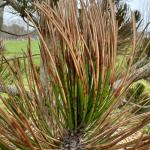 Brown spot needle blight, caused by Lecanosticta acicola, on a Satellit Bosnian pine (Pinus heldreichii ‘Satellit’). This young tree is part of the UMass Utility Arboretum, a collection of 60 trees were planted to showcase plants appropriate for planting under power lines (i.e. tress with a maximum height around 30’). The tree resides in full sun with good natural soil moisture and no supplemental irrigation. Symptoms of the disease include blighted needle tips and scattered brown spots towards the base of the needle. The pathogen was confirmed after incubation and microscopic analysis of the symptomatic needles. The tree is badly diseased and while needle blights rarely kill pines outright, the stress makes them more susceptible to insect attack, drought stress and winter injury. Without chemical treatment, this tree will continue to suffer a serious case of disease. Brown spot needle blight has a wide host range among two-, three-, and five-needle pines that are native and non-native in the region.
Brown spot needle blight, caused by Lecanosticta acicola, on a Satellit Bosnian pine (Pinus heldreichii ‘Satellit’). This young tree is part of the UMass Utility Arboretum, a collection of 60 trees were planted to showcase plants appropriate for planting under power lines (i.e. tress with a maximum height around 30’). The tree resides in full sun with good natural soil moisture and no supplemental irrigation. Symptoms of the disease include blighted needle tips and scattered brown spots towards the base of the needle. The pathogen was confirmed after incubation and microscopic analysis of the symptomatic needles. The tree is badly diseased and while needle blights rarely kill pines outright, the stress makes them more susceptible to insect attack, drought stress and winter injury. Without chemical treatment, this tree will continue to suffer a serious case of disease. Brown spot needle blight has a wide host range among two-, three-, and five-needle pines that are native and non-native in the region.
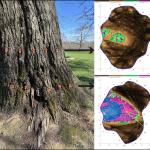 Root and butt rot of black oak (Quercus velutina) caused by Armillaria. This mature black oak resides on the UMass campus near the football stadium. While generally left undisturbed, there are periods of heavy foot traffic around the tree. It receives full sun in good, loam soils. Dead bark and decaying wood on the root flare and lower trunk was first detected in 2018. The pattern of wood decay and presence of rhizomorphs indicated that Armillaria was the causal agent. The tree was subsequently scanned using sonic and electrical resistance tomography to determine the severity of decay. At the time, approximately 30% of the cross section at the lower scanning height (40 cm or ~16 in. from the soil line) was damaged. The tree was recently re-scanned at the same heights and the latest results showed approximately 36% of the cross-sectional area was damaged at the lower height (violet and blue area of sonic tomogram on lower right). While this appears to be only modest decay development over a six-year period (2018 to 2024), the diameter of the lower trunk at the 40 cm sampling height has increased from 124 cm (49 in.) to 139 cm (55 in.). Therefore, while the decay is expanding within the lower trunk the tree has been able to grow significantly in diameter. This is the ideal scenario when decay in the lower trunk is present. If the tree’s growth can remain robust, it can hopefully outpace the rate of decay. At the upper scanning height (90 cm or ~35”), decay is minimal, illustrating how at times internal decay remains confined to the lowest portions of the trunk. One aspect that cannot be accounted for is decay in the root system.
Root and butt rot of black oak (Quercus velutina) caused by Armillaria. This mature black oak resides on the UMass campus near the football stadium. While generally left undisturbed, there are periods of heavy foot traffic around the tree. It receives full sun in good, loam soils. Dead bark and decaying wood on the root flare and lower trunk was first detected in 2018. The pattern of wood decay and presence of rhizomorphs indicated that Armillaria was the causal agent. The tree was subsequently scanned using sonic and electrical resistance tomography to determine the severity of decay. At the time, approximately 30% of the cross section at the lower scanning height (40 cm or ~16 in. from the soil line) was damaged. The tree was recently re-scanned at the same heights and the latest results showed approximately 36% of the cross-sectional area was damaged at the lower height (violet and blue area of sonic tomogram on lower right). While this appears to be only modest decay development over a six-year period (2018 to 2024), the diameter of the lower trunk at the 40 cm sampling height has increased from 124 cm (49 in.) to 139 cm (55 in.). Therefore, while the decay is expanding within the lower trunk the tree has been able to grow significantly in diameter. This is the ideal scenario when decay in the lower trunk is present. If the tree’s growth can remain robust, it can hopefully outpace the rate of decay. At the upper scanning height (90 cm or ~35”), decay is minimal, illustrating how at times internal decay remains confined to the lowest portions of the trunk. One aspect that cannot be accounted for is decay in the root system.
Report by Nick Brazee, Plant Pathologist, UMass Extension Plant Diagnostic Lab, UMass Amherst
Insects and Other Arthropods
The Professional Insect and Mite Management Guide for Woody Plants is freely available at https://ag.umass.edu/insectmiteguide. Please let me know how it is or isn’t working for you here. Your feedback is valuable and I cannot wait to hear from you!
Note: Our website is undergoing updates, and as such, the collapsible menus on the home page of the Guide are currently not functioning. Thank you for your patience as we await these updates.
Invasive Updates:
- Asian Longhorned Beetle is still present in Worcester, Shrewsbury, Boylston, West Boylston, and parts of Holden and Auburn, MA. If you suspect you’ve found this insect or the damage it causes, please report it to the Asian Longhorned Beetle Eradication Program office in Worcester, MA at 508-852-8090 or toll free at 1-866-702-9938.
To report an Asian longhorned beetle find online or to compare it to common insect look-alikes, visit: http://massnrc.org/pests/albreport.aspx
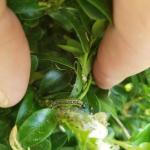 Box Tree Moth has been detected in the following Massachusetts communities: Bourne, Sandwich, and Barnstable. A map of these locations is available here. If you believe you have found this insect, please take a photo, note your location, and report it immediately here. Box tree moth caterpillars were reported to be active at certain locations on Cape Cod, MA as of the week of April 19th. See Landscape Message #3 and the Cape Cod Region Report.
Box Tree Moth has been detected in the following Massachusetts communities: Bourne, Sandwich, and Barnstable. A map of these locations is available here. If you believe you have found this insect, please take a photo, note your location, and report it immediately here. Box tree moth caterpillars were reported to be active at certain locations on Cape Cod, MA as of the week of April 19th. See Landscape Message #3 and the Cape Cod Region Report.

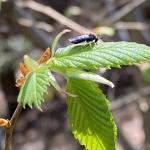 Elm Zigzag Sawfly has been detected in the following Massachusetts communities: Becket, Chester, Windsor, and Williamstown. If you believe you have found this insect, please take a photo, note your location, and report it immediately here. Elm zigzag sawfly adults are active as of 5/2/2024 at a previously infested site in Berkshire County (first detected in 2023). See photo courtesy of Nicole Keleher, MA DCR Forest Health Program.
Elm Zigzag Sawfly has been detected in the following Massachusetts communities: Becket, Chester, Windsor, and Williamstown. If you believe you have found this insect, please take a photo, note your location, and report it immediately here. Elm zigzag sawfly adults are active as of 5/2/2024 at a previously infested site in Berkshire County (first detected in 2023). See photo courtesy of Nicole Keleher, MA DCR Forest Health Program.
- Emerald Ash Borer is well established across most of Massachusetts. A map of these locations from the MA Department of Conservation and Recreation is available.

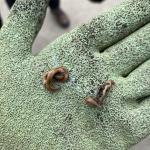 Hammerhead Worms: Also known as flatworms or land planarians, belong to Phylum Platyheminthes (flat worms) rather than Arthropoda (arthropods) which makes them different from insects and their relatives. Class Insecta is the taxonomic classification of the Insects, whereas hammerhead worms belong to Class Turbellaria. A few common species of non-native hammerhead worms noted in New England include but are not limited to: Bipalium kewense, Bipalium adventitium, and Bipalium pensylvanicum. Sightings of these organisms have increased in recent years, possibly due to warming winters and wet summers. Hammerhead worms are predators that prefer to feed on earthworms; however, depending upon the species involved, they may not be an effective predator of certain species of jumping worms. Again in 2024, reports of hammerhead worms have come from parts of Massachusetts (in this case, Martha’s Vineyard; see photos) with questions about safety. Hammerhead worms are known to produce a neurotoxin (tetrodotoxin) which they use in self-defense and to subdue prey. Luckily, hammerhead worms do not produce enough tetrodotoxin to be lethal to humans, but if the neurotoxin comes into contact with exposed skin, irritation may occur. It is advised that handling hammerhead worms should be avoided, and hands or exposed skin be washed with soap and water following any accidental contact.
Hammerhead Worms: Also known as flatworms or land planarians, belong to Phylum Platyheminthes (flat worms) rather than Arthropoda (arthropods) which makes them different from insects and their relatives. Class Insecta is the taxonomic classification of the Insects, whereas hammerhead worms belong to Class Turbellaria. A few common species of non-native hammerhead worms noted in New England include but are not limited to: Bipalium kewense, Bipalium adventitium, and Bipalium pensylvanicum. Sightings of these organisms have increased in recent years, possibly due to warming winters and wet summers. Hammerhead worms are predators that prefer to feed on earthworms; however, depending upon the species involved, they may not be an effective predator of certain species of jumping worms. Again in 2024, reports of hammerhead worms have come from parts of Massachusetts (in this case, Martha’s Vineyard; see photos) with questions about safety. Hammerhead worms are known to produce a neurotoxin (tetrodotoxin) which they use in self-defense and to subdue prey. Luckily, hammerhead worms do not produce enough tetrodotoxin to be lethal to humans, but if the neurotoxin comes into contact with exposed skin, irritation may occur. It is advised that handling hammerhead worms should be avoided, and hands or exposed skin be washed with soap and water following any accidental contact.- Jumping Worms are non-native earthworms that impact natural ecosystems. Available resources include a fact sheet about earthworms in Massachusetts and jumping worm FAQ’s.
- Spotted Lanternfly now has established populations in the following locations in Massachusetts: Holyoke, Springfield, West Springfield, Agawam, Fitchburg, Worcester, Shrewsbury, Southborough, Ashland, Wellesley, Weston, and Chelmsford. If you believe you have found this insect, please take a photo, note your location, and report it immediately here. Available resources include a map of spotted lanternfly locations in Massachusetts from the MA Department of Agricultural Resources, MDAR’s spotted lanternfly fact sheet, UMass Extension’s Spotted Lanternfly Management Guide, and an SLF InsectXaminer episode.
Medically Important Pests:
- Ticks are a serious public health concern and may be active in managed landscapes any time temperatures are above freezing. Encounters with deer ticks can increase in New England in April, October, and November; however, precautions should be taken year-round to prevent tick bite exposure. Available resources include tick information from Cape Cod Cooperative Extension, personal protective measures, and a list of potential tick testing resources. The New England Center of Excellence in Vector-Borne Diseases (NEWVEC) also provides the latest tick information and resources.
- Mosquitoes and the diseases they vector are also a serious public health concern in Massachusetts by summer. Available resources include Mosquito Repellents from the Department of Public Health and Prevent Mosquito Bites from the Centers for Disease Control and Prevention. The Massachusetts Department of Public Health tests for Eastern Equine Encephalitis (EEE) and West Nile Virus (WNV) from June to October. Beginning in June, risk maps will be available here.
Tree & Shrub Insect & Mite Pest Suggested Scouting:
- Bagworm is overwintering on Juniperus spp., Thuja spp., Quercus spp., Platanus spp., and others as 500-1000 eggs can be found in the bags of last season’s deceased females. Now is the time to remove and destroy overwintering bags of eggs prior to egg hatch at approximately 600 GDD’s (approx. mid-June).
- Balsam Twig Aphid overwinters as eggs on host plant bark, trunks, and branches (primarily Abies and Picea spp.). Eggs hatch roughly between 30-120 GDD’s, approximately April-May. Nymphs quickly mature into stem mothers, which produce 20-40 young (each) without laying eggs. These young feed on buds and tender needles, and cause most of their feeding damage during that time. Scout now for curled or stunted needles from feeding in prior years.
 Balsam-fir Root Aphid was reported by a Christmas tree grower in Athol, MA on young transplants on 4/30/2024. This aphid alternates between ash or lilac species host plants and the roots of fir, including Fraser fir (Abies fraseri) such as what is pictured here. It is uncertain the amount of damage this root aphid may cause on fir species host plants. It is likely negligible on mature or established trees without additional stress factors. Young plants may experience some loss of fine roots when aphid numbers exceed 100 per seedling.
Balsam-fir Root Aphid was reported by a Christmas tree grower in Athol, MA on young transplants on 4/30/2024. This aphid alternates between ash or lilac species host plants and the roots of fir, including Fraser fir (Abies fraseri) such as what is pictured here. It is uncertain the amount of damage this root aphid may cause on fir species host plants. It is likely negligible on mature or established trees without additional stress factors. Young plants may experience some loss of fine roots when aphid numbers exceed 100 per seedling. - Black Turpentine Beetle overwinters as an adult in the bark of its host plants. Adults may become active as temperatures rise, typically by mid-April to mid-May. Attacked host trees may ooze 1.6 inch diameter red or white masses of pitch from the lower 6 feet of the trunk. Pitch pine, eastern white pine, and other species of pine or spruce may be hosts for this insect. Frequently an issue on stressed trees in eastern Massachusetts. Favored by drought or flooding conditions.
- Boxwood Leafminer is overwintering as a partially developed larva within Buxus spp. leaves. Larvae will become active as temperatures warm, with pupae present by late April. Adult emergence occurs by mid-May, with pupal cases left behind clinging to leaves. Shake bushes in late April to detect flying adults. Resistant varieties of boxwood are available; see preceding link.
- Boxwood Mite feeds on upper and lower leaf surfaces of Buxus spp. hosts. Overwintered eggs hatch into larvae in the spring, which mature into nymphs and eventually adults. The entire life cycle takes approximately 18-21 days. Most feeding injury occurs in the spring and hosts may appear off-color.
- Boxwood Psyllid nymphs have overwintered within eggshells inserted between bud scales last summer. As soon as buds expand, nymphs will emerge and begin feeding on Buxus spp. developing buds and leaves. Upward cupping and yellowing of leaves can be a sign of previous or current season’s damage. Dormant season horticultural oil applications may be made in the spring, as temperatures and weather conditions allow.
- Cankerworms can be found feeding on similar host plants in the spring, despite fall and spring cankerworm being different species of insects. Spring cankerworm adult moths are active in February and March, laying masses of 100 or so eggs in the rough bark of larger branches or the trunk of the host plant. Fall cankerworm adults laid their masses of eggs on host plant branches and twigs, back in late November and early December of last year (sometimes the current year’s January). Egg hatch of both species will occur by approximately mid-May, with caterpillar feeding through roughly the end of June.
- Cooley Spruce Gall Adelgid typically overwinters as an immature female near spruce twig terminals. By early spring, this female matures into a stem mother which will lay hundreds of eggs on lateral terminals. Following egg hatch, nymphal feeding induces gall formation on spruce hosts. Green galls on spruce may be removed and destroyed. On Douglas fir, the Cooley spruce gall adelgid’s alternate host, look for woolly masses in the spring and distorted or crooked needles. Do not plant spruce and Douglas fir close together when possible.
- Dogwood Borer is a species of clearwing moth whose larvae bore not only into dogwood (Cornus), but hosts also include flowering cherry, chestnut, apple, mountain ash, hickory, pecan, willow, birch, bayberry, oak, hazel, myrtle, and others. Kousa dogwood appears to be resistant to this species. Signs include the sloughing of loose bark, brown frass, particularly near bark cracks and wounds, dead branches, and adventitious growth. The timing of adult emergence can be expected when dogwood flower petals are dropping and weigela begins to bloom. Adult moth flights continue from then until September.
- Dogwood Sawfly overwinters as a larva in an overwintering “cell” created in soft, decaying wood material. Pupation occurs in the spring, and adults may emerge by late May through July. Eggs are laid in the underside of the host plant leaf, in groups of 100 or more.
- Eastern Spruce Gall Adelgid overwinters as a partially grown female, maturing into a stem mother by early spring. Stem mothers lay 100-200 eggs by budbreak. Eggs hatch and nymphs feed on the needles of their Picea spp. hosts. As green galls develop, prune out and destroy when possible.
- Eastern Tent Caterpillar overwintering eggs hatch in the spring and caterpillars emerge as cherry leaves begin to open. Look for groups of caterpillars feeding in silken tents at that time.
- Elm Leaf Beetle overwinters as an adult in protected areas, such as the loose bark of trees. Sometimes, they enter homes in search of a safe winter haven, and become a nuisance. As host plant leaves emerge, beetles fly back to chew small, semi-circular holes in the leaves. Eggs are laid in clusters on leaves and resemble pointy footballs. Each female can lay 600-800 eggs.
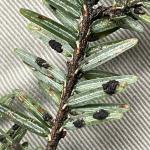
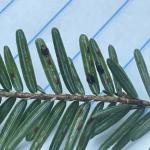 Elongate Hemlock Scale is primarily a pest of hemlock and fir. Overwintered fertilized females or their eggs will become active with warming temperatures, with egg hatch generally occurring by the end of May or the beginning of June. At that time, crawlers will be present before they settle to feed on a needle. Colletotrichum fioriniae was observed on elongate hemlock scales in Lynnfield, MA on 2/23/2024 and again in Manchester, MA on 3/19/2024 by Richard Grant (see photos). C. fioriniae is an endophytic fungus that lives within the needles of hemlock. Up to 90% mortality can occur in elongate hemlock scale if this fungus invades the insect. Scales appear coated in a black material, looking similar to sooty mold (it is not sooty mold). This fungus was reported as active in elongate hemlock scale populations in western MA in 2023 as well.
Elongate Hemlock Scale is primarily a pest of hemlock and fir. Overwintered fertilized females or their eggs will become active with warming temperatures, with egg hatch generally occurring by the end of May or the beginning of June. At that time, crawlers will be present before they settle to feed on a needle. Colletotrichum fioriniae was observed on elongate hemlock scales in Lynnfield, MA on 2/23/2024 and again in Manchester, MA on 3/19/2024 by Richard Grant (see photos). C. fioriniae is an endophytic fungus that lives within the needles of hemlock. Up to 90% mortality can occur in elongate hemlock scale if this fungus invades the insect. Scales appear coated in a black material, looking similar to sooty mold (it is not sooty mold). This fungus was reported as active in elongate hemlock scale populations in western MA in 2023 as well.- Euonymus Caterpillar tiny, overwintered larvae have spent their time beneath eggshells from last year. As temperatures increase in the spring, groups of caterpillars will begin feeding on newly emerging Euonymus spp. leaves. Additional resources include an InsectXaminer episode about euonymus caterpillar.
- Euonymus Scale overwinters as a fertilized female. Eggs are laid beneath dark brown female scale covers in the early spring. Egg hatch occurs over a 2-3 week period, with crawlers present by early June. While Euonymus spp. host plants are preferred, additional host plants have been reported.
- European Elm Scale is a non-native scale that is widespread in North America on native and European elms, in addition to hackberry and Zelkova. Adult females are black with a ring of white fibers around their bodies and may be found in branch forks or rough/creviced areas of the bark. By the end of June, females will produce eggs that hatch into crawlers. Crawlers will disperse to the underside of elm leaves and leaf midveins to feed.
- European Pine Sawfly eggs have overwintered in slits in last year’s needles. Egg hatch begins in approximately late-April and early May.
- Fletcher Scale is a soft scale pest of yew, juniper, and arborvitae. Feeding scales, especially on yew, result in honeydew and sooty mold, needle yellowing, and at times, premature needle drop. There is one generation per year. Overwintered second instar nymphs can be targeted between 38-148 GDD’s, base 50°F. Nymphs develop and adult females lay eggs (on average 500-600) in May that hatch by June. Dead females conceal egg masses beneath. Crawlers migrate short distances to branches and may be concentrated on certain branches of a particular plant.
- Forest Tent Caterpillar egg masses overwinter and will hatch as leaves expand in the spring. Small caterpillars will search for expanding flower and leaf buds to begin feeding on.
- Hemlock Looper collectively refers to two species of geometrid (inchworm; looper) caterpillars. Overwintered eggs hatch by late May or early June, at which time young larvae begin their messy feeding on host plant needles. Hemlock and balsam fir are preferred hosts.
- Hemlock Woolly Adelgid has been favored this winter by the mild temperatures we’ve experienced in Massachusetts, according to the MA Department of Conservation and Recreation. Very little overwintering mortality has been measured at sites sampled across the state. Overwintered sistens generation females produce viable eggs in February and March.
- Honeylocust Plant Bug feeding results in tiny yellowish-brownish spots on leaves, leaf distortion, and in some cases, defoliation. (There are at least 7 species of plant bugs that feed on honeylocust, Gleditsia triacanthos.) There is one generation per year. Immatures and adults feed on foliage and light to moderately damaged foliage may persist throughout the growing season. Honeylocust plant bugs overwinter as eggs laid just beneath the bark surface of 2 and 3 year old twigs. Eggs hatch just after vegetative bugs of the host begin to open. Young nymphs crawl to the opening leaflets and begin feeding and the most significant damage occurs at that time, when the insect is hidden from view. Nymphs develop into adults around May-July. This insect can be targeted between 58-246 GDD’s, base 50°F.
- Imported Willow Leaf Beetle adults overwinter in loose bark or other sheltered areas near susceptible Salix and Populus spp. host plants. Once the host plant leaves emerge in the spring, adults will begin to feed and lay tiny, yellow eggs in clusters on leaf undersides. Additional resources include an InsectXaminer episode about imported willow leaf beetle.
- Japanese Cedar Longhorned Beetle cause damage to arborvitae, cypress, juniper, and cedar (Chamaecyparis). Feeding damage from the larvae of this species causes branch dieback, which is typically not noticed until the springtime following the initial infestation. 1/8-inch oval exit holes, galleries beneath the bark (in the cambium and xylem), and frass may be signs of the activity of this insect. Take precautions to avoid host plant stress. May go unnoticed until a plant needs to be removed.
- Lecanium Scales, including most notably in Massachusetts, the oak lecanium, are soft scales that overwinter on host plant twigs as second instar immatures. In the spring, these immatures begin feeding and mature into hemispherical shaped adult females who lay their eggs by late May and into June. Between April and May, much honeydew (sugary excrement) may be produced by the active adult females.
- Lilac Borer is a clearwing moth pest of lilac, privet, fringetree, and ash. (It is also known as the ash borer, not to be confused with the emerald ash borer.) Adults mimic paper wasps. Larvae are wood-boring, and signs and symptoms include branch dieback, holes, and occasionally, sawdust-like frass accumulated on bark. Larvae bore into stems, trunks, and branches, chewing an irregularly shaped entrance hole. Peak adult moth flights may occur in the northern portion of this insect’s range in June and is usually over by August 1st. Pheromone traps can be used to time adult emergence. Adult females lay flattened, oval, and tan eggs that are deposited singly or in clusters on bark crevices, ridges, and sometimes smooth bark; but usually laid in or near wounds in the bark. On average, 395 eggs are laid by each female. After hatch, larvae chew into the bark and feed laterally and then vertically in phloem tissue. Larvae overwinter in tunnels in the final instar and resume feeding in the spring. Adults emerge through a round exit hole (4-5 mm. in diameter). This insect may be targeted between 200-299 GDD’s, base 50°F.
- Lily Leaf Beetle, while not a pest of trees and shrubs, can be an important insect found in ornamental landscapes. As soon as lilies break through the ground in the spring, bright red overwintered adult beetles begin feeding on the foliage. This typically occurs in April, with adults mating and laying eggs by May; 250-450 eggs may be laid per female. Additional resources include an InsectXaminer episode about lily leaf beetle.
- Magnolia Scale overwinters as nymphs (immatures) found on 1 and 2-year old twigs of the host plant. Nymphs begin feeding as temperatures warm in the spring, molting once by late April or May and again by early June.
- Pine Bark Adelgid overwinters in an immature form which begins feeding again as springtime temperatures increase. This is the time when the insects begin secreting a white, waxy layer over their bodies. High populations can make the trunks of eastern white pine appear as if coated in snow. Typically, management is not necessary. Syringing (washing adelgids off the trunk of larger trees with a strong jet of water) is an option.
- Pitch Mass Borer overwinters in the pitch mass found on the host plant. This insect tunnels beneath the bark, into the cambium. It may take up to two years for the pitch mass borer to mature. Pupation typically occurs by the end of May through June, in time for adult clearwing moth emergence in July and August.
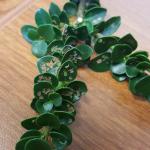
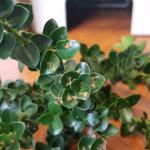 Redheaded Flea Beetle (Systena frontalis) has been identified as a native pest of nurseries in many locations in the eastern United States. Suspected redheaded flea beetle damage was seen on Ilex crenata 'Dwarf Pagoda' (Dwarf Pagoda Japanese holly) on 3/27/2024 that was purchased in Massachusetts but may have originated in NJ. While identification of this species of insect is uncertain based on host plant damage alone, it appears to be a reasonable and educated assumption. Redheaded flea beetles are known to feed on a wide variety of host plants. These include but are not limited to: cabbage, beans, beets, blueberries, and other agricultural crops as well as Physocarpus, Weigelia, Cornus, Forsythia, Itea, Hydrangea, and Ilex. Adult beetles are active and feed from approximately late-June to mid-September on the upper and lower leaf surfaces of their hosts. This can cause damage that looks like skeletonization and eventually holes in the leaves. Leaves appear covered in brown patches as in these photos. This damage was caused last season on this evergreen plant.
Redheaded Flea Beetle (Systena frontalis) has been identified as a native pest of nurseries in many locations in the eastern United States. Suspected redheaded flea beetle damage was seen on Ilex crenata 'Dwarf Pagoda' (Dwarf Pagoda Japanese holly) on 3/27/2024 that was purchased in Massachusetts but may have originated in NJ. While identification of this species of insect is uncertain based on host plant damage alone, it appears to be a reasonable and educated assumption. Redheaded flea beetles are known to feed on a wide variety of host plants. These include but are not limited to: cabbage, beans, beets, blueberries, and other agricultural crops as well as Physocarpus, Weigelia, Cornus, Forsythia, Itea, Hydrangea, and Ilex. Adult beetles are active and feed from approximately late-June to mid-September on the upper and lower leaf surfaces of their hosts. This can cause damage that looks like skeletonization and eventually holes in the leaves. Leaves appear covered in brown patches as in these photos. This damage was caused last season on this evergreen plant.- Snowball Aphid overwinters as an egg on the twigs and buds of Viburnum spp. hosts. Egg hatch occurs at the same time host plant buds are opening in the spring. Newly hatched aphids will begin to feed on and distort the newly developing leaves of their hosts. Aphids may be protected from contact insecticides within curled leaves.
- Southern Pine Beetle has been trapped in Massachusetts since 2015. By 2022 and 2023, southern pine beetle has reached outbreak conditions in small areas of the state, killing pitch pine (Pinus rigida). (Particularly on Martha’s Vineyard and Nantucket islands in MA.) If you believe you have found infested pitch pine in Massachusetts, please report southern pine beetle here.
- Spruce Bud Scale overwinters as an immature scale on the undersides of host plant needles. Once spring temperatures warm, the dormant scales become active by late March and in April female spruce bud scales move to host plant twigs. Adult females are reddish-brown and round, and usually found at the base of new twig growth.
- Spruce Spider Mite is a cool season mite which causes most of its feeding damage on coniferous hosts in the spring and fall. Monitor for discolored needles and the mites themselves. Monitoring for spruce spider mite can be done by shaking 3-4 branches over a white piece of paper and viewing mites with a hand lens.
- Tuliptree Scale is a soft scale pest of Liriodendron and Magnolia spp. among others. Second instar nymphs overwinter, begin feeding as temperatures warm in the spring, and mature into adults by the late spring/early summer.
- Viburnum Leaf Beetle overwinters on susceptible viburnum as eggs laid in pits chewed near the ends of twigs last season. These egg laying locations are covered with an oval-round cap. Prune out and destroy infested twigs prior to egg hatch in May.
- White Pine Aphid eggs overwinter in rows on the needles of their host plants. Egg hatch will occur as spring temperatures begin to warm. Aphids may feed on the needles, twigs, and small branches of their host plants.
- White Pine Weevil overwinters as an adult in the leaf litter in sheltered areas near host plants. As spring temperatures warm, adults fly to the leaders of Pinus and Picea spp. hosts where they mate, dig round holes in the bark, and deposit 1-5 tiny eggs in the cavity. Eggs hatch and the larvae tunnel as they feed, killing the previous season’s leader. Adult white pine weevils are active in March (through May), as soon as 7 GDD’s are reached.

 Woolly Apple Aphid overwinters as eggs in the cracks and crevices of Ulmus spp. host plants. As spring temperatures warm, these eggs hatch and stem mothers begin feeding on developing elm leaves. Their feeding and the feeding of the wingless nymphs they produce causes leaf distortion and a rosette to form on elm. If no elm is present, the aphids will complete their life cycle on apple year-round. Woolly apple aphid feeding distortion was seen on new elm foliage on the UMass Amherst campus on 5/1/2024.
Woolly Apple Aphid overwinters as eggs in the cracks and crevices of Ulmus spp. host plants. As spring temperatures warm, these eggs hatch and stem mothers begin feeding on developing elm leaves. Their feeding and the feeding of the wingless nymphs they produce causes leaf distortion and a rosette to form on elm. If no elm is present, the aphids will complete their life cycle on apple year-round. Woolly apple aphid feeding distortion was seen on new elm foliage on the UMass Amherst campus on 5/1/2024.- Woolly Beech Leaf Aphid overwinters as eggs in host plant bark crevices near buds. At budbreak, eggs hatch and wool covered aphids begin feeding on host plant leaf undersides (Fagus spp.). Even though aphid populations may be very noticeable, they seldom require chemical management.
- Woolly Elm Aphid overwinters as eggs hidden in cracks and crevices of elm bark. As leaves unfold in the spring, eggs hatch and young aphids feed on the underside of elm leaf tissue. These aphids mature and give birth to hundreds of additional females. Feeding causes leaves to curl around the aphids. Curled leaves may also turn reddish brown.
Beneficials/Non-Pests:
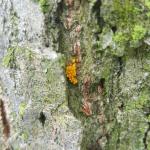 Multicolored Asian Lady Beetles are an example of one of those insects whose status is all in the eyes of the beholder. Some may prefer them as beneficial insects or classical biological control organisms in managed landscapes. (They are non-native insects and were released purposefully into the United States as a part of a biological control program. They feed on soft bodied insects, such as aphids.) In the case of this photo from 5/1/2024 on the UMass Amherst campus, these multicolored Asian lady beetle eggs were laid on an elm that perpetually has issues with woolly apple aphid (see above entry) and European elm scale. These eggs will hatch, and the lady beetle larvae will feed on the developing woolly apple aphids. Free pest management! However, the “dark” side of the multicolored Asian lady beetle is that the adults sometimes enter homes in large numbers to overwinter, to the displeasure of homeowners. Additionally, there is concern that this non-native species of lady beetle might be outcompeting and displacing other native species of lady beetles. Either way, these soon-to-be larvae will really enjoy the aphids developing on this elm tree.
Multicolored Asian Lady Beetles are an example of one of those insects whose status is all in the eyes of the beholder. Some may prefer them as beneficial insects or classical biological control organisms in managed landscapes. (They are non-native insects and were released purposefully into the United States as a part of a biological control program. They feed on soft bodied insects, such as aphids.) In the case of this photo from 5/1/2024 on the UMass Amherst campus, these multicolored Asian lady beetle eggs were laid on an elm that perpetually has issues with woolly apple aphid (see above entry) and European elm scale. These eggs will hatch, and the lady beetle larvae will feed on the developing woolly apple aphids. Free pest management! However, the “dark” side of the multicolored Asian lady beetle is that the adults sometimes enter homes in large numbers to overwinter, to the displeasure of homeowners. Additionally, there is concern that this non-native species of lady beetle might be outcompeting and displacing other native species of lady beetles. Either way, these soon-to-be larvae will really enjoy the aphids developing on this elm tree.
Report by Tawny Simisky, Extension Entomologist, UMass Extension Landscape, Nursery & Urban Forestry Program
Landscape Weeds
Preemergence herbicide applications for annual grass control should definitely be on the front burner as forsythia (Forsythia intermedia) is in full flower and new green foliage is appearing. Forsythia is the phenological indicator for the application of preemergence herbicides. Applications of these herbicides should be applied when forsythia is in full bloom, with the last application occurring as the first few flowers hit the ground (typically late April to very, very early May).
Many winter annual weeds are coming out of winter dormancy and are beginning to flower in turf and landscape areas. The recent warm weather has pushed most winter annual weeds of turf and landscape to full flower. Attempting to control these weeds now will decrease the number of seeds they produce. Winter annuals will complete their life cycle as the weather continues to warm. A fresh layer of landscape mulch will control them by smothering. If populations are dense in turf, especially in areas that were seeded to establish a turf last fall, a broadleaf herbicide combination should be considered. Common winter annual weeds being observed now are include mouse-ear cress (Arabidopsis thaliana), thymeleaf sandwort (Arenaria serpyllifolia), shepherd's-purse (Capsella bursa-pastoris), hairy bittercress (Cardamine hirsuta), sticky chickweed (Cerastium viscosum), spring whitlowgrass (Draba verna), henbit (Lamium amplexicaule), red deadnettle (Lamium purpureum), Virginia pepperweed (Lepidium virginicum), knawel (Scleranthus annuus), common chickweed (Stellaria media), corn speedwell (Veronica arvensis), and purslane speedwell (Veronica peregrina).
Landscape mulch should be the first defense against weeds in landscape beds. Mulching can be done now at the beginning of the season before summer annual weeds germinate. Small winter annual weeds can be smothered with mulch. Freshly mulched landscape beds will not immediately require a preemergence herbicide application because the fresh mulch should supply adequate summer annual weed control in the short term. Preemergence herbicide application should be considered on mulched areas that have not been freshly mulched or can be applied later in the season in those areas that were freshly mulched this spring. Preemergence herbicides should be applied on top of landscape mulches not underneath them. Compost is not recommended as a mulching material.
Lesser celandine, also called fig buttercup, fig-crowfoot, or dusky maiden (Ficaria verna or Ranunculus ficaria), is an herbaceous invasive perennial plant found throughout New England. This species is a spring ephemeral, with shiny, dark green, kidney-shaped leaves and bright-yellow, glossy flowers with 8 to 12 petals. Lesser celandine reproduces by bulblets, tuberous roots, and seeds. As a spring ephemeral, it is only apparent in the spring and dormant the rest of the year, so it is often difficult to determine if an herbicide worked or the symptoms you see are just the species becoming dormant later in the spring or early summer. Herbicides known to effectively control lesser celandine in turf are triclopyr and dicamba. Products that contain both herbicides are the best choice. Populations of lesser celandine in landscape beds can be controlled with directed-spray applications of glyphosate. For early occurrences of this weed in new locations consider digging plants up and disposing of them in a matter that will prevent their further spread.
A sample of annual ryegrass (Lolium multiflorum) was received in the UMass Plant Diagnostic Lab this week, taken from residential turf. The occurrence of this weedy grass coincided with an area that was over-seeded last August and was attributed to the use of a poor quality turf seed mix. At this time of the growing season, annual ryegrass and a few other weedy grasses have a leaf and stem elongation rate that is higher than our typical cool-season turf species used in the Northeast. As there is no herbicide that will selectively manage annual ryegrass in a cool-season turf stand, the recommendation is to just continue to mow the turf until the higher leaf and stem elongation period passes. The turf professional stated that the area was not very large and decided to physically remove the annual ryegrass with a knife.
Tree seedlings are continuing to germinate in landscape beds and some locations may have seedlings that are 2 to 3 inches tall. These seedlings can be treated with pelargonic acid (ScytheTM). Another option would be to cut these seedlings with a gas, electric or battery powered hedge shear at the soil or mulch surface. The organic/non-chemical products do not translocate and will not provide effective control of these young tree seedlings. Tree seedlings in turf areas will be controlled with mowing and an herbicide application is not necessary.
Report by Randy Prostak, Weed Specialist, UMass Extension Landscape, Nursery, and Urban Forestry Program
Additional Resources
Pesticide License Exams - The MA Dept. of Agricultural Resources (MDAR) is now holding exams online. For more information and how to register, go to: https://www.mass.gov/pesticide-examination-and-licensing.
To receive immediate notification when the next Landscape Message update is posted, join our e-mail list or follow us on Facebook.
For a complete listing of landscape, nursery, and urban forestry program upcoming events, see our calendar at https://ag.umass.edu/landscape/upcoming-events.
For commercial growers of greenhouse crops and flowers - Check out UMass Extension's Greenhouse Update website.
For professional turf managers - Check out our Turf Management Updates.
For home gardeners and garden retailers - Check out our home lawn and garden resources.
Diagnostic Services
UMass Laboratory Diagnoses Landscape and Turf Problems - The UMass Extension Plant Diagnostic Lab is available to serve commercial landscape contractors, turf managers, arborists, nurseries and other green industry professionals. It provides woody plant and turf disease analysis, woody plant and turf insect identification, turfgrass identification, weed identification, and offers a report of pest management strategies that are research based, economically sound and environmentally appropriate for the situation. Accurate diagnosis for a turf or landscape problem can often eliminate or reduce the need for pesticide use. For sampling procedures, detailed submission instructions and a list of fees, see the Plant Diagnostic Laboratory web site.
Soil and Plant Nutrient Testing - The University of Massachusetts Soil and Plant Nutrient Testing Laboratory is located on the campus of the University of Massachusetts at Amherst. Testing services are available to all. The lab provides test results and recommendations that lead to the wise and economical use of soils and soil amendments. For more information, including current turn-around times, visit the UMass Soil and Plant Nutrient Testing Laboratory web site. The lab is currently accepting orders for Routine Soil Analysis (including optional Organic Matter, Soluble Salts, and Nitrate testing), Particle Size Analysis, Pre-Sidedress Nitrate (PSNT), Total Sorbed Metals, and Soilless Media (no other types of soil analyses available at this time). Check for current turnaround time. Please plan for the fact that date of receipt in the lab is affected by weekends, holidays, shipping time, and time for UMass Campus Mail to deliver samples to the lab.
Tick Testing - The UMass Center for Agriculture, Food, and the Environment provides a list of potential tick identification and testing options at https://ag.umass.edu/resources/tick-testing-resources.
Acknowledgements: UMass Extension gratefully acknowledges the support of the following funding sources for the production of the Landscape Message –
- The Massachusetts Nursery and Landscape Association Fund
- The Massachusetts Department of Conservation and Recreation, Award #ISADCR28219926UMA24A
- Stakeholders like you! The Landscape Message is partially supported by educational program user fees.